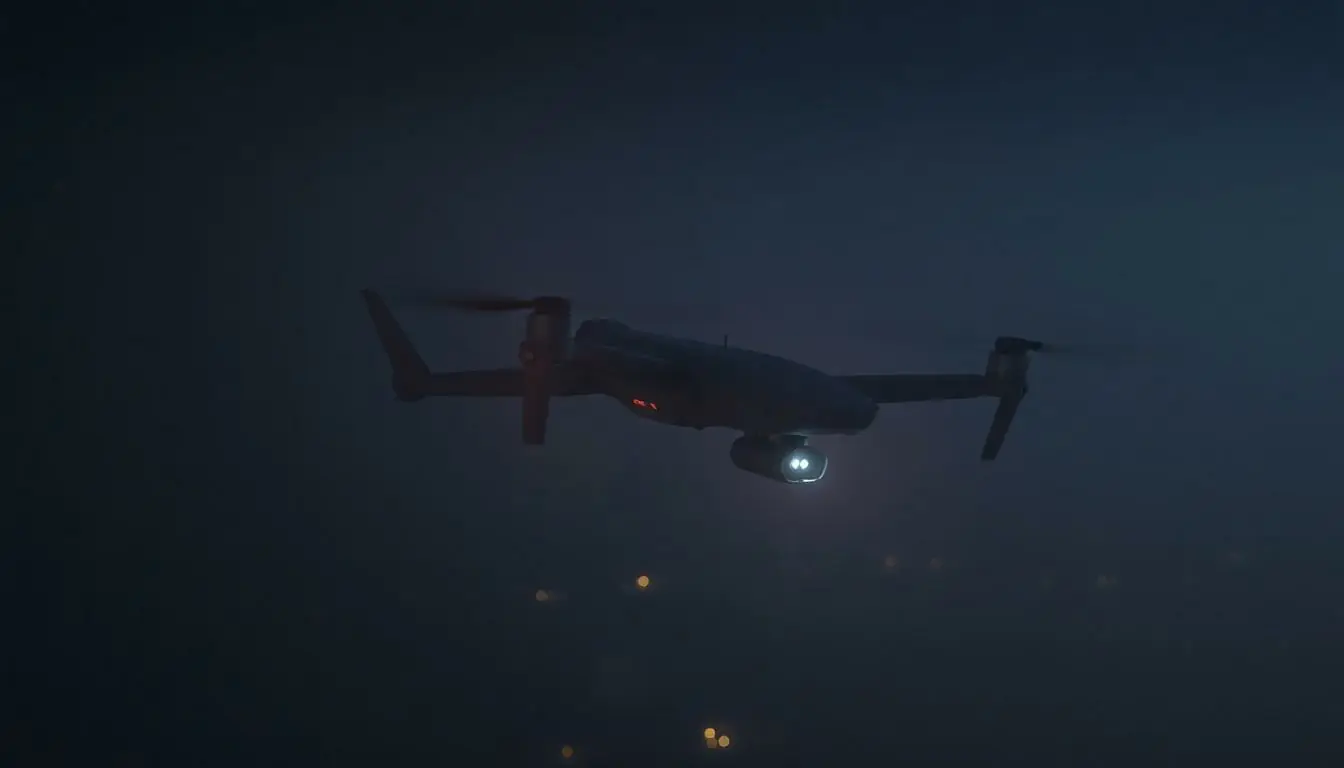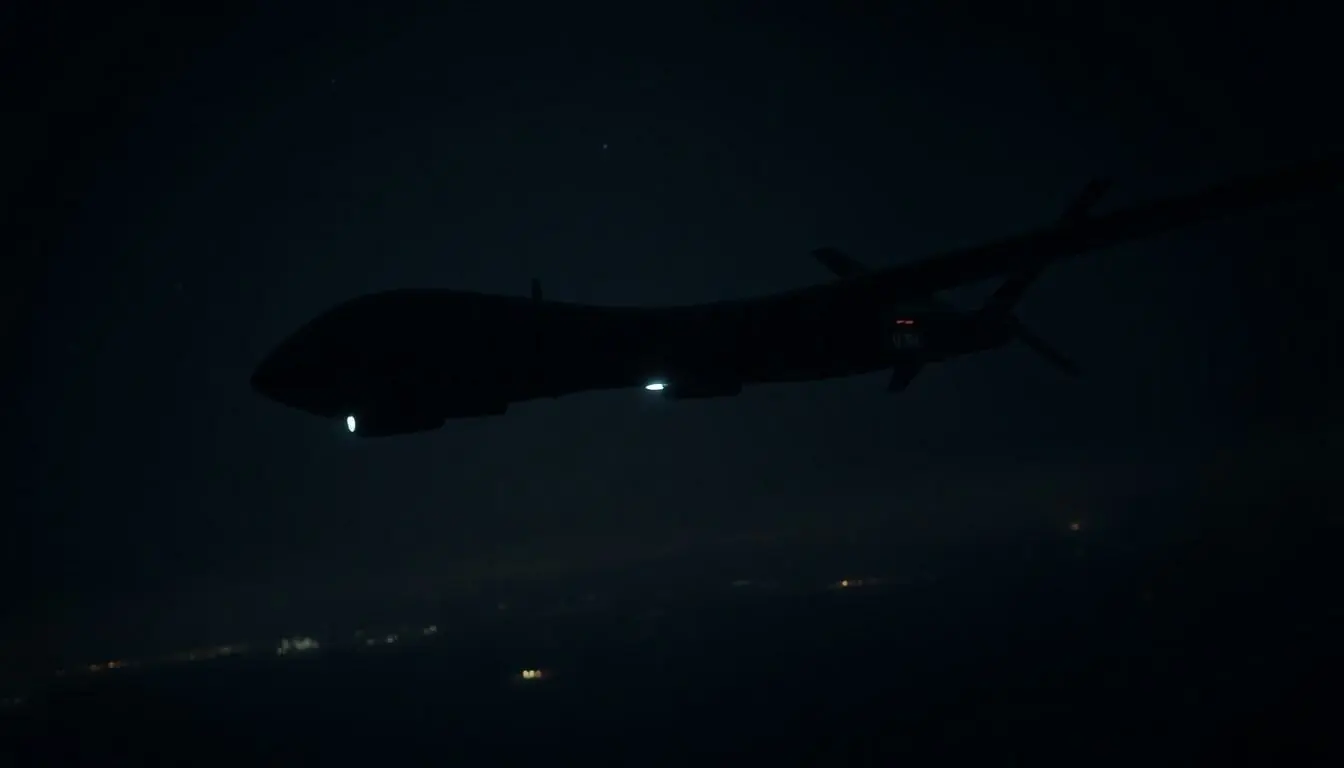When the sun sets and the stars come out, the battlefield transforms into a realm of shadows and uncertainty. Enter military drones—those high-tech marvels that don’t just fly by day, but also rule the night sky. Imagine a sleek, buzzing machine gliding through the darkness, equipped with night vision that would make even an owl jealous. These drones bring a whole new meaning to “keeping an eye on things.”
As they soar silently above, they gather intelligence and execute missions with precision, proving that not all heroes wear capes. With advanced technology and stealth capabilities, military drones are redefining nighttime operations, ensuring that the only thing lurking in the dark is the enemy’s anxiety. So buckle up as we dive into the fascinating world of military drones at night, where innovation meets the thrill of the chase.
Table of Contents
ToggleOverview of Military Drones
Military drones serve crucial functions in modern warfare. Equipped with state-of-the-art technology, these unmanned aerial vehicles enhance operational efficiency during nighttime missions. Night vision capabilities empower military drones to perform surveillance and reconnaissance in low-light conditions. These features allow for real-time intelligence gathering, often without detection.
Advanced sensors and imaging systems further increase their effectiveness. They capture high-resolution images and videos, aiding decision-making processes. Additionally, some drones incorporate synthetic aperture radar, allowing them to detect ground targets regardless of weather conditions.
The stealth design of many military drones reduces their radar signature, helping them operate undetected. This strategic advantage elevates psychological warfare, instilling anxiety in adversaries during nighttime operations.
Data gathered by drones supports various military operations. Roles include target acquisition, strike coordination, and monitoring troop movements. By deploying unmanned systems, militaries enhance situational awareness and minimize risks to personnel.
Numerous models exist, including the MQ-9 Reaper and the RQ-4 Global Hawk. Each model possesses unique capabilities tailored for specific operational needs. The integration of drones in military operations marks a significant evolution in combat tactics, ensuring that forces maintain a tactical edge at all times.
Capabilities of Military Drones at Night

Military drones excel at nighttime operations, equipped with state-of-the-art technology that enhances their effectiveness. Their capabilities significantly transform modern warfare.
Advanced Imaging Technologies
Advanced imaging technologies empower military drones to capture detailed visuals at night. High-resolution cameras, combined with synthetic aperture radar, enable the identification of targets despite poor light conditions. These imaging systems gather real-time data, helping commanders make informed decisions swiftly. Drones like the MQ-9 Reaper utilize these technologies for reconnaissance missions, ensuring operational success even during the darkest hours. The integration of multispectral sensors further allows for different wavelengths analysis, broadening detection capabilities and improving mission outcomes.
Night Vision and Infrared Sensors
Night vision and infrared sensors play a crucial role in military drone operations after sunset. These sensors detect heat signatures, allowing pilots to identify vehicles and personnel in complete darkness. The technology provides a tactical advantage by facilitating surveillance and target acquisition under obscured conditions. Drones equipped with infrared capabilities enhance situational awareness significantly, allowing for precise strikes while maintaining stealth. This innovative approach minimizes the risk of detection, ensuring operational effectiveness during nighttime missions.
Applications in Night Operations
Military drones excel in various applications during night operations, significantly enhancing tactical advantages. Their capabilities in surveillance and reconnaissance, as well as target acquisition and strikes, transform effective military strategy.
Surveillance and Reconnaissance
Surveillance functions include continuous monitoring of enemy movements. Equipped with high-resolution cameras and multispectral sensors, drones gather crucial intelligence in darkness. Night vision and infrared sensors detect heat signatures, providing real-time visibility even under challenging conditions. Commanders utilize collected data for strategic planning, gaining insights into terrain and troop positioning. Drones maintain a low profile, reducing detection risk while maximizing information retrieval. Various models offer specific enhancements for surveillance, ensuring mission success.
Target Acquisition and Strikes
Target acquisition benefits significantly from drone technology during nighttime operations. Drones identify and track targets with high precision, relying on advanced imaging systems for accurate assessments. Infrared capabilities allow for effective engagement of enemy positions without compromising operational secrecy. Strike missions occur with optimal timing, leveraging real-time data to guide decisions. Efficient coordination between drones and ground troops is essential for successful operations. These capabilities enable military forces to engage targets quickly, ensuring mission success with minimal collateral damage.
Challenges Faced by Military Drones at Night
Military drones encounter various challenges during nighttime operations that affect their performance and mission success. Understanding these obstacles helps improve their effectiveness.
Weather Conditions
Adverse weather directly impacts military drone operations at night. Rain, snow, and fog can severely reduce visibility, complicating data collection and analysis. While drones equipped with advanced sensors can mitigate some visibility issues, heavy precipitation or strong winds can hinder stability and control. Specific weather conditions may obscure infrared signatures, limiting target detection. Tactical planning must account for these variables to ensure successful engagements. Pilots and operators remain mindful of weather forecasts to adjust their strategic approaches.
Signal Interference
Signal interference presents a significant challenge for military drones during nighttime missions. Dense urban environments and mountainous terrains can obstruct communication signals, complicating control and data transmission. High-frequency signals used for guidance and surveillance face risks from jamming technologies employed by adversaries. The effectiveness of drone operations decreases when operators cannot receive real-time information. Advanced countermeasures are essential to combat these challenges, ensuring secure and uninterrupted communication throughout missions. Maintaining signal integrity plays a critical role in operational success.
Future Developments in Night Drone Technology
Innovations shape the future of military drones in nighttime operations. Emerging technologies promise enhanced capabilities. For instance, artificial intelligence integration boosts real-time data analysis and decision-making. Advanced algorithms can process imagery rapidly, improving target identification accuracy.
Next-generation sensors will see significant upgrades. High-definition thermal imaging and multispectral sensors contribute to better visibility in complete darkness. Future drones may also feature advanced radar systems that detect smaller objects, allowing for precise reconnaissance missions.
Collaboration with satellite technology plays a crucial role. Enhanced communication links between drones and satellites will provide uninterrupted data transmission. This capability ensures continuous operation even in adverse conditions, addressing current challenges in signal interference.
Autonomous operation represents another trend in night drone technology. Self-piloting drones will execute missions with minimal human intervention, streamlining processes in high-risk environments. Such advancements enhance operational efficiency and reduce the risks associated with human error.
The potential for swarm technology is also noteworthy. Coordinated groups of drones could deploy simultaneously to cover vast areas. This strategy allows military forces to conduct large-scale surveillance and reconnaissance while maintaining stealth.
Overall, future developments in night drone technology promise to enhance operational capabilities. Emerging technologies foster better performance, minimize risks, and ensure mission success—essential factors in modern warfare tactics.
Military drones are revolutionizing nighttime operations by leveraging cutting-edge technology and stealth capabilities. Their ability to gather intelligence and execute missions under the cover of darkness not only enhances operational efficiency but also instills a sense of anxiety in adversaries. As advancements continue in imaging technologies and artificial intelligence, the effectiveness of these unmanned aerial vehicles will only increase.
Future developments promise even greater capabilities in data analysis and communication, ensuring military forces maintain a tactical edge in complex environments. The evolution of military drones signifies a transformative shift in modern warfare, where the night becomes an arena for strategic advantage.



